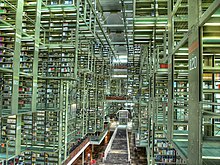Alberto Kalach | |
|---|---|
 | |
| Born | 1960 |
| Nationality | Mexican |
| Alma mater | Universidad Iberoamericana, Cornell University |
| Occupation | Architect |
| Projects | Jose Vasconcelos Library |
Alberto Kalach (born 1960) is a Mexican architect.
Alberto Kalach | |
|---|---|
 | |
| Born | 1960 |
| Nationality | Mexican |
| Alma mater | Universidad Iberoamericana, Cornell University |
| Occupation | Architect |
| Projects | Jose Vasconcelos Library |
Alberto Kalach (born 1960) is a Mexican architect.
Alberto Kalach is of Jewish descent, born in Mexico City, studied architecture at the Universidad Iberoamericana, Mexico City, and completed graduate studies later at Cornell University in Ithaca. In 1981 he founded the firm "Taller de Arquitectura X" with Daniel Álvarez, with whom he worked until 2002, when Álvarez left the firm. While he continues to direct TAX, in 2002 his interests also turned to the urban planning problems of his home town, and founded the community "México: future city" (Spanish : México: ciudad futura). He realized several joint projects, some of them with notable colleagues like Teodoro González de León, Gustavo Lipkau and Jose Castillo. His lake concepts were significant in solving existing water supply problems in Mexico City. He published several articles in national and international magazines of architecture, [1] [2] and participates in the "Recovering the City of Lakes" project (Spanish : Vuelta a la ciudad lacustre). [3] Del mismo modo, ha mostrado un remarcable interés por el urbanismo, especialmente los de la Ciudad de México, [4] por lo cual ha realizado diversos proyectos de gran escala dentro del colectivo que fundó llamado México: Ciudad Futura, donde han participado arquitectos de gran importancia como lo son Teodoro González de León, Gustavo Lipkau y José Castillo.


Puebla de Zaragoza, formally Heroica Puebla de Zaragoza, formerly Puebla de los Ángeles during colonial times, or known in English simply as Puebla, is the seat of Puebla Municipality. It is the capital and largest city of the state of Puebla, and the fourth largest city in Mexico, after Mexico City, Monterrey, and Guadalajara. A viceregal era planned city, it is located in the southern part of Central Mexico on the main route between Mexico City and Mexico's main Atlantic port, Veracruz—about 100 km (62 mi) east southeast of Mexico City and about 220 km (140 mi) west of Veracruz.

Puebla, officially Free and Sovereign State of Puebla, is one of the 32 states which comprise the Federal Entities of Mexico. It is divided into 217 municipalities and its capital is the city of Puebla.

Club Puebla, formerly Puebla F.C. is a Mexican professional football club based in the city of Puebla, competing in the Liga MX. Known as La Franja, the team shirt features a diagonal stripe that crosses the chest diagonally from right to left, which is considered a distinctive element of its identity.

Universidad La Salle also referred to by its acronym ULSA is a private Catholic secondary and higher education institution run by the Institute of the Brothers of the Christian Schools in 15 campuses in Mexico. It offers high school, bachelor, master and Ph.D degrees. It has had an expansion in the country, creating its own university national system. Its main campus is located in Mexico City, and has a presence in Ciudad Obregón, Chihuahua, Gomez Palacio, Monterrey, Ciudad Victoria, Leon, Morelia, Pachuca, Ciudad Nezahualcóyotl, Puebla, Oaxaca, Cancun, Cuernavaca and Saltillo.

The School of Architecture at UNAM is one of the leading schools of architecture and design in Mexico. It offers undergraduate and postgraduate studies in architecture, landscape architecture, urbanism and industrial design.

Many of Mexico's older architectural structures, including entire sections of Pre-Hispanic and colonial cities, have been designated World Heritage sites for their historical and artistic significance. The country has the largest number of sites declared World Heritage Sites by UNESCO in the Americas.

Sebastián is a Mexican sculptor best known for his monumental works of steel and/or concrete in both Mexico and abroad. These include a number of “gate” sculptures such as the Gran Puerta a México in Matamoros, Tamaulipas but his most famous sculpture is the “Caballito” located in downtown Mexico City. His works are found in various countries outside Mexico, such as Japan where two are now used as city symbols.
Aurelio Nuño Morales was a Mexican architect.

Teodoro González de León was a Mexican architect.
Augusto Harold Álvarez García was a Mexican Modernist architect.
Juan José Díaz Infante Núñez was a Mexican architect and industrial designer.
Events in the year 1982 in Mexico.
Events from the year 1911 in Mexico.
Events in the year 1959 in Mexico.
Events in the year 1986 in Mexico.
Events in the year 1984 in Mexico.
Events in the year 1977 in Mexico.
Events in the year 1969 in Mexico.

The Hospital Universitario 12 de Octubre is a public general hospital in the neighborhood of Orcasur, in Madrid, Spain. It is part of the hospital network of the Servicio Madrileño de Salud (SERMAS).